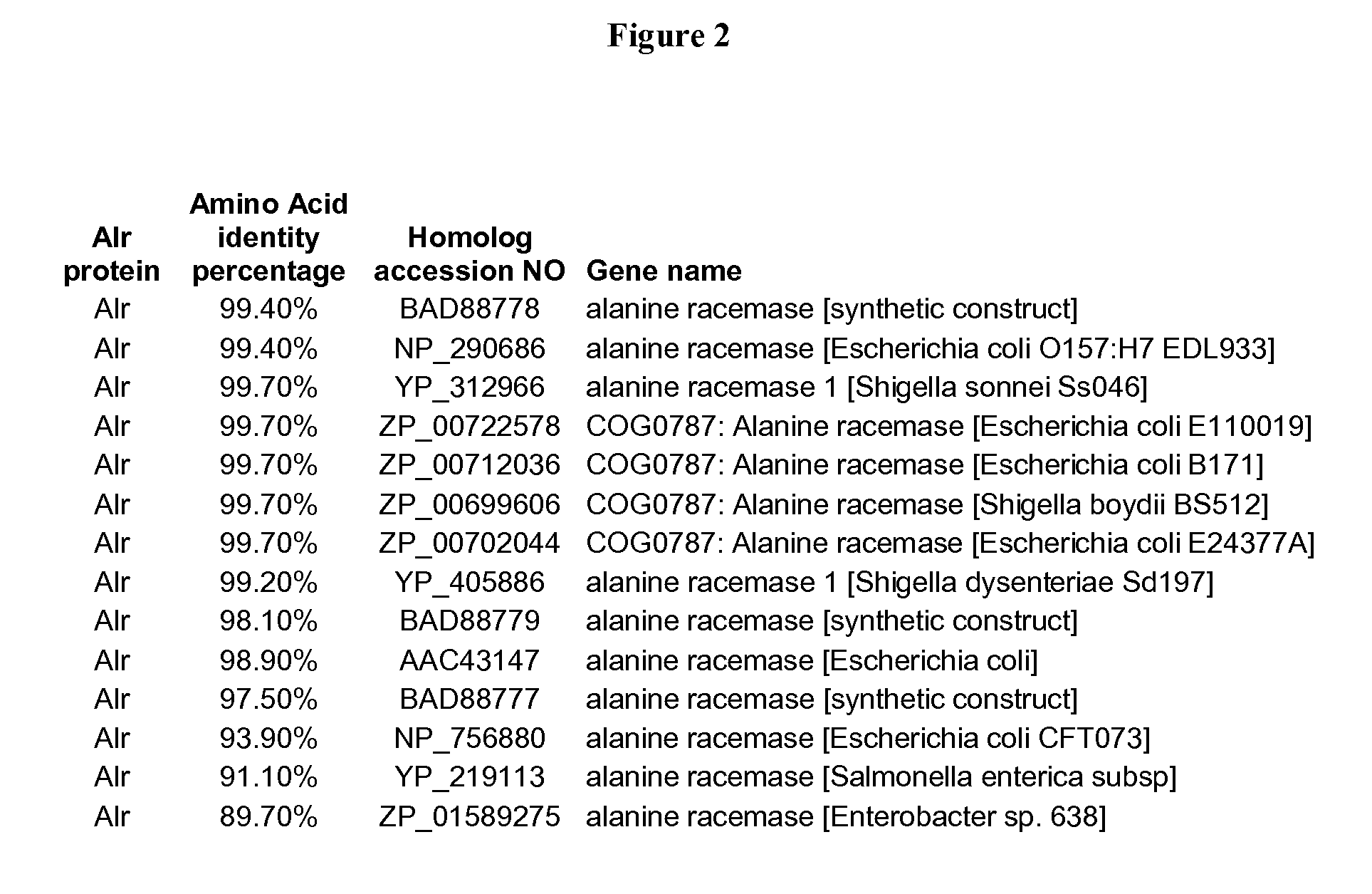Use of Alanine Racemase Genes to Confer Nematode Resistance to Plants
a technology of alanine racemase and nematode resistance, which is applied in the direction of plant genotype modification, fermentation, biochemistry apparatus and processes, etc., can solve the problems of wilting of plants, soybean production is no longer economically possible without, and the estimated $100 billion crop loss worldwide, so as to achieve nematode resistance to plants, overcome, or overcom
- Summary
- Abstract
- Description
- Claims
- Application Information
AI Technical Summary
Benefits of technology
Problems solved by technology
Method used
Image
Examples
example 1
Cloning of Alanine Racemase Encoding Genes
[0080]The two forms of alanine racemase, Alr (SEQ ID NO:7) and DadX (Seq ID NO:5), were cloned from E. coli genomic DNA using PCR primers shown in Table 1.
TABLE 1Primers used to clone the ARLNCP coding genesSEQPrimerPur-IDnameSequenceposeNO:PrimerGCGGCGCGCCACCATGACCCGTCCGATACAGGCDadX11-5′DadXprimerPrimerGCCTCGAGTTACACCGTCACAACCGGGACGCDadX22-3′DadXprimerPrimerGCGGCGCGCCACCATGCAAGCGGCAACTGTTGTGAIr 5′31-AIrprimerPrimerGCCTCGAGTTAATCCACGTATTTCATCGCGACAIr 3′42-AIrprimer
example 2
Vector Construction for Transformation and Generation of Transgenic Roots
[0081]PCR products generated in Example 1 were sequenced and cloned into a number of expression vectors containing syncytia preferred (nematode induced) promoters. The syncytia preferred promoters included soybean MTN3 SEQ ID NO:9 (p-47116125) (U.S. Ser. No. 60 / 899,714), Arabidopsis peroxidase PDX SEQ ID NO:10 (p-At5g05340) (U.S. Ser. No. 60 / 876,416) and Arabidopsis TPP trehalose-6-phosphate phosphatase SEQ ID NO:11 (p-At1g35910) (U.S. Ser. No. 60 / 874,375). The constitutive super promoter was also used. The selection marker for transformation was a mutated acetohydroxy acid synthase (AHAS) gene from Arabidopsis thaliana that conferred resistance to the herbicide ARSENAL (imazepyr, BASF Corporation, Mount Olive, N.J.). The expression of mutated AHAS was driven by the Arabidopsis actin 2 promoter.
TABLE 2expression vector comprising SEQ ID NO: 5 or 7Composition of the expression vectorvector(promoter::ARLNCP encod...
example 3
Generation of Transgenic Soybean Hairy-Root and Nematode Bioassay
[0082]Vectors RSH118, RSH120, RSH122, RSH117, RSH125, RSH127, RSH129 and RSH124 were transformed into A. rhizogenes K599 strain by electroporation. The transformed strains of Agrobacterium were used to induce soybean hairy-root formation using known methods. Non-transgenic hairy roots from soybean cultivar Williams 82 (SCN susceptible) and Jack (SCN resistant) were also generated by using non-transformed A. rhizogenes, to serve as controls for nematode growth in the assay.
[0083]A bioassay to assess nematode resistance was performed on the transgenic hairy-root transformed with the vectors and on non-transgenic hairy roots from Williams 82 and Jack as controls. Hairy root cultures of each line that occupied at least half of the well were inoculated with surface-decontaminated race 3 of soybean cyst nematode (SCN) second stage juveniles (J2). The plates were then sealed and put back into the incubator at 25° C. in darkne...
PUM
| Property | Measurement | Unit |
|---|---|---|
| resistance | aaaaa | aaaaa |
| nematode resistance | aaaaa | aaaaa |
| temperature | aaaaa | aaaaa |
Abstract
Description
Claims
Application Information
 Login to View More
Login to View More - R&D
- Intellectual Property
- Life Sciences
- Materials
- Tech Scout
- Unparalleled Data Quality
- Higher Quality Content
- 60% Fewer Hallucinations
Browse by: Latest US Patents, China's latest patents, Technical Efficacy Thesaurus, Application Domain, Technology Topic, Popular Technical Reports.
© 2025 PatSnap. All rights reserved.Legal|Privacy policy|Modern Slavery Act Transparency Statement|Sitemap|About US| Contact US: help@patsnap.com



